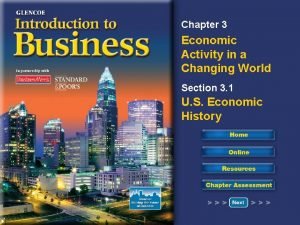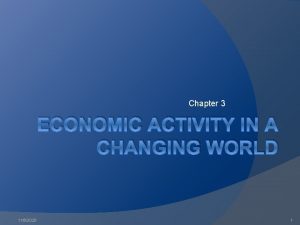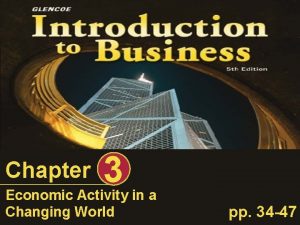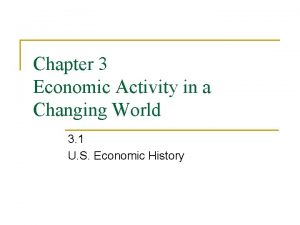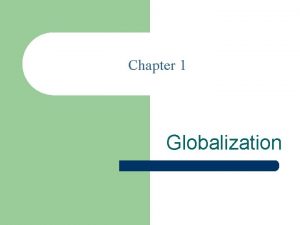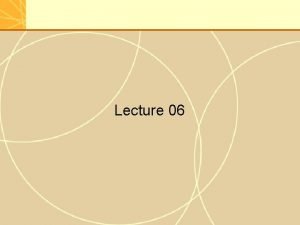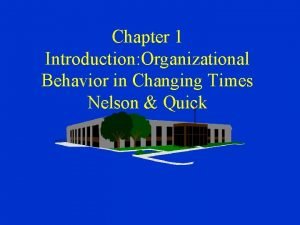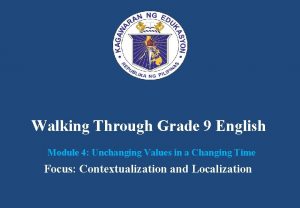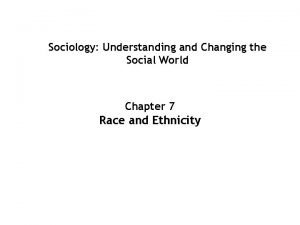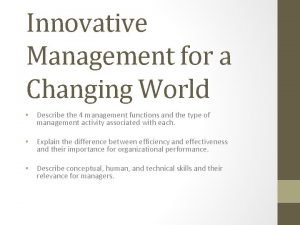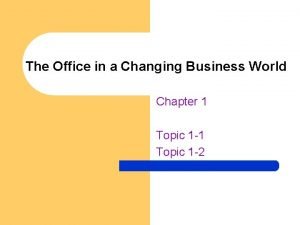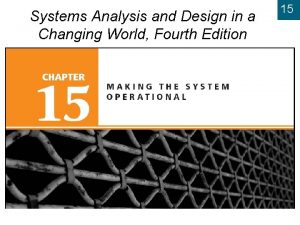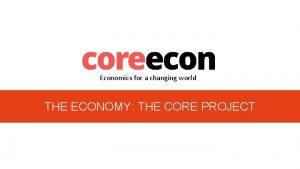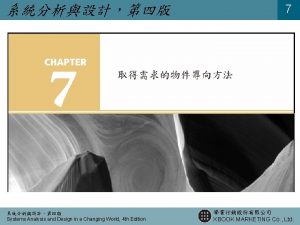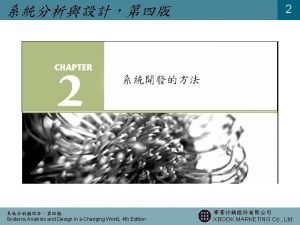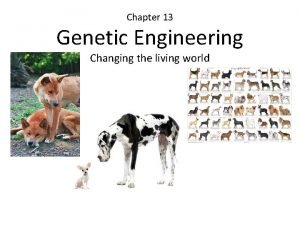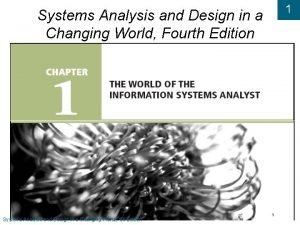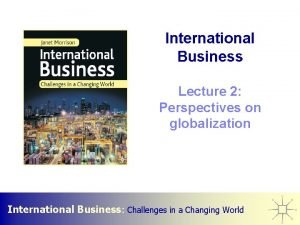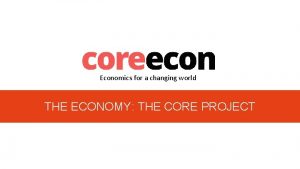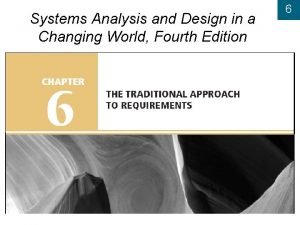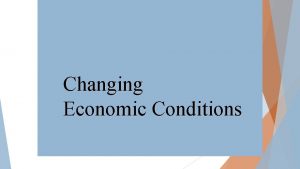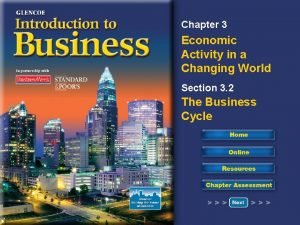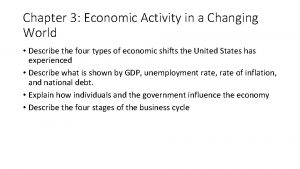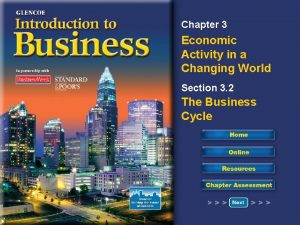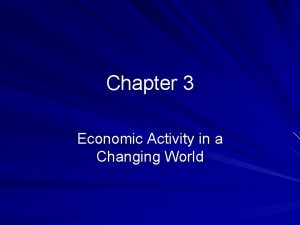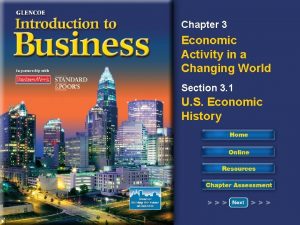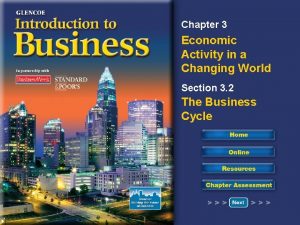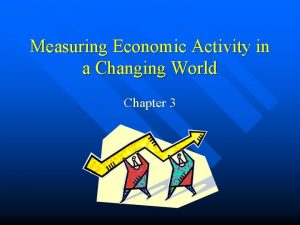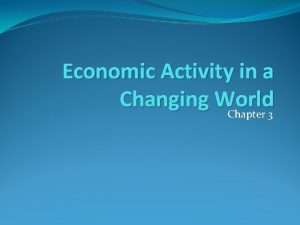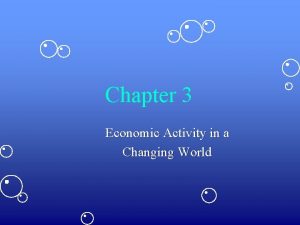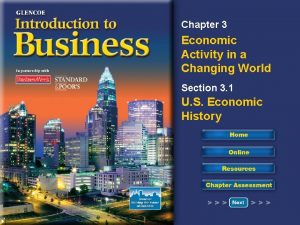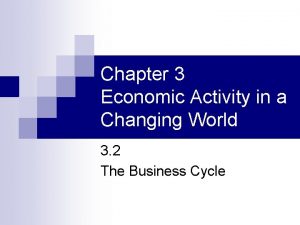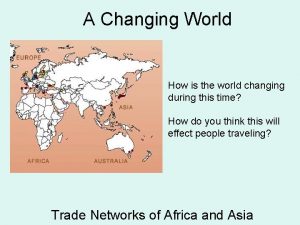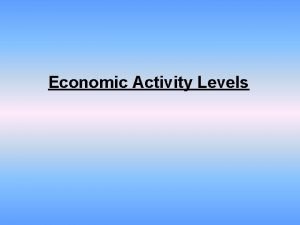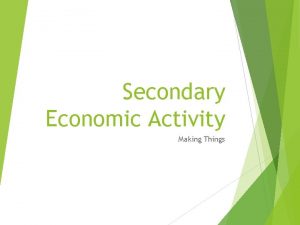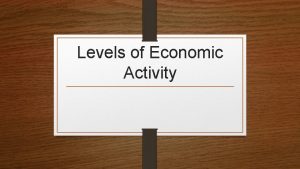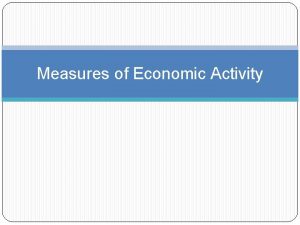Chapter 3 Economic Activity in a Changing World



























- Slides: 27

Chapter 3: Economic Activity in a Changing World • Describe the four types of economic shifts the United States has experienced • Describe what is shown by GDP, unemployment rate, rate of inflation, and national debt. • Explain how individuals and the government influence the economy • Describe the four stages of the business cycle

Key vocab • • • Gross Domestic Product Standard of living Inflation Deflation Stagflation Budget deficit National debt Budget surplus Prosperity Recession • Depression • Recovery

Calculating interest Price Interest rate $7, 500 7% $7, 450 8% $8, 200 5% Interest (Price x Interest rate) Total value ((price x (1+interest rate)

The Changing Us Economy • Throughout the years, the US economic system has changed. Each change affected what was produced and how people were employed. To gauge the health of our economic system, we use a variety of economic indicators • • • In the 1600’s we bartered goods and services In the 1700’s farming revolutionized civilization and allowed for cities In the mid-1850’s the Industrial Revolution started In the 1900 s information starts to move at a rapid pace to spur innovation Today we are mostly technology based, what will be the change of the future?

How is our Economy Doing? • 6 Key economic indicators 1. 2. 3. 4. 5. 6. Gross Domestic Product The Consumer price index Industrial production Interest rates Non-farm payroll Unemployment rate

How is our economy doing? • Gross Domestic Product (GDP)- measures the dollar value of all goods and services produced in the U. S. economy in one year. • This is measured by the Department of Commerce Bureau of Economic Analysis • Add the spending in the consumer, investment (firms), government, and foreign (exports minus imports) sectors • We must remove the effects of inflation from current GDP to compare the current figures to GDP numbers from other years. • Real GDP is the current GDP divided by the GDP price deflator. • The real GDP is one of the most important indicators of economic performance. • A rise in real GDP indicates economic growth, while a fall in real GDP indicates economic decline

How is Our Economy Doing? • The consumer price index compares the value of a basket of goods for urban customers over time. • An examples would be bread, milk, cereal, some vegetables, and some fruit • This index is compared month-to-month, year-over-year, or its trend. • This is kept by the Bureau of Labor and Statistics • This is usually a lagging indicator of economic health

How is our Economy Doing? • Industrial Production measures the output of American industry. • The Federal Reserve Board of Governors measures Industrial Production by calculating the manufacturing output in the consumer goods, business equipment, construction supplies, materials, manufacturing, mining, and utility industries. • Production is calculated in each sector monthly, and the percentage change in output is reported as Industrial Production. • Durable goods, such as cars, appliances, and furniture, as well as construction supplies, tend to be more sensitive to economic changes than are other manufacturing products. • Generally, Industrial Production increases during economic growth and falls during periods of economic decline

How is our Economy Doing? • The Ten-Year Treasury Interest Rate measures the percentage return investors receive on U. S. Treasury bonds. • The Federal Reserve Board of Governors measures Ten-Year Treasury Interest Rates, as determined daily in the bond market. • Treasury Interest Rates can be indicative of changes in other longterm interest rates such as mortgages and long-term business loans. • A decline in interest rates can precede increased investment spending to promote economic growth; high interest rates can lead to lower levels of investment and a decline in the rate of growth

How is our Economy Doing? • The Change in Non-farm Payroll measures the number of people employed by companies and government. • The Department of Labor Bureau of Labor Statistics surveys approximately 390, 000 establishments to count the number of people employed each month, and the change from the previous month in the number of employed people is reported as the Change in Non-farm Payrolls. • Non-farm Payroll generally rises during economic growth and falls during economic decline.

How is our Economy Doing? • The Unemployment Rate measures the percentage of people in the labor force who were not working during the week of the survey, but had specifically looked for work within the previous four weeks (unless they were waiting to be recalled from layoff, in which case they need not have been looking for work to be counted as unemployed). • The Department of Labor Bureau of Labor Statistics surveys thousands of Americans each month to calculate the size of the labor force (those working plus those not working, but seeking work) and the unemployment rate (the unemployed divided by the labor force). • The number of people unemployed as a percentage of the labor force is reported each month as the Unemployment Rate. • The Unemployment Rate generally falls during economic growth and rises during economic decline

Ethics in business • You are the purchasing agent for a large furniture manufacturer. You have received several bids from lumber companies for a supply of teak, a very dense and decay resistant type of wood. The lowest bid comes from a lumber company that has been known for not placing a strong emphasis on local environmental concerns, especially resource depletion, when it cuts down trees. • How would the lumber company’s reputation affect your decision?

The Business Cycle • In a market economy, there is an economic cycle, which includes four stages: prosperity, recession, depression, recovery. There also the four stages in the business cycle. • How would this cycle work in sports? • The government and congress enact laws to influence fiscal policy • Spending tax payer’s money and creating a “balanced” budget • The Federal Reserve (The Fed) regulates the amount of money in circulation, controlling interest rates, and controlling how much money banks can loan out.

The Business Cycle • Prosperity- low unemployment, high production of goods and services, high levels of investment, • Recession- 2 consecutive quarters of negative growth in the economy • Recovery- the economy starts to grow, unemployment lowers, and production increases • Depression- high unemployment, and low production of goods and services • October 29, 1929 “Black Tuesday” Beginning of the Great Depression • 1929 -1933 GDP fell $103 B to $55 B • Unemployment went from 1. 6 M to 12. 8 M • Wages went from $. 55 to $. 05 • In March 1933 a bank holiday was declared to prevent a panic • Where are we right now? ? ?

Economist Profile • Research famous economists • You will create a short presentation on the life of the economist including • • • Biography Schooling Employment Economic theory/beliefs List of Publications

Chapter 3 Quiz • Fill-in-the-blank

Chapter 4: Business ethics and Social Responsibility • Define ethics and business ethics • Describe why ethical behavior is good for business • List the steps for dealing with an ethical dilemma • Define what is meant by the social responsibility of business

Key vocab • Ethics • Business ethics • Code of ethics • Sweatshop • Conflict of interest

Business Math • Calculating the Future value of money • You made $4, 000 one summer working various jobs. You have two options: one spend all the money or save and invest the money. • What are the benefits of spending all $4, 000? • What about saving and investing? • Calculate the future value of your money assuming a 5% annually compounding interest rate after 50 years. • FV=PV(1+interest rate)^time

The Nature of Ethics • What would you do if you found a copy of your final exam in the hallway? • What would you do if you found a diamond ring in a restaurant? • Ethics are moral principles by which people conduct themselves personally, socially, and professionally. Business ethics are rules that guide the behavior of a business and its employees. • Some cultures have different ideas for ethics. In the United States, bribery is highly illegal and unethical. In India bribery in encouraged

Laws and Ethics • Ethics involve moral principles that govern conduct • Laws involve rules for conduct that may be used to punish violators • March 25, 1911 the Triangle Shirtwaist factory Company in NYC had a fire which killed 146 workers- mostly young immigrant female workers • Termed a sweatshop • The Occupational Safety and Health Administration (OSHA) which is a division of the US Department of Labor now oversees workplace safety and rules.

Ethical Decision Making 1. Identify the ethical dilemma 2. Discover alternative actions 3. Decide who might be affected 4. List the probable effects of the alternatives 5. Select the best alternative

Social Responsibility • Is it the duty of a business to do what is best for the good of society? Producing goods and services that are beneficial to society and providing jobs for people are not sufficient for a business to be considered socially responsible. They are expected to do more. • Some examples are that the LA times uses recycled paper and Automakers are starting to make hybrid cars that create less emissions • Why are businesses held to such a standard? Does the government do this? Or even individuals? • The Equal Pay act of 1964 requires that men and women be paid the same wages for doing equal work • The Americans with Disabilities Act bans discrimination against people with physical and mental disabilities

Social Responsibility • Employers owe it to their employees to take care of them financially and at the work site • At the end of the day you will always have people work for you and happiness is directly related to retention and productivity. • Businesses are usually based in a community and have a responsibility to help out with the local area since it is mutually beneficial • The real owner of the business is the shareholders, creditors, and out right owners. • The whole point of investing in a company is to see it get better and create value • Companies represent their financial performance to the public so they can choose to invest or not • Sarbanes-Oxley Act

Thematic Project • Research trends that are affecting businesses and careers and create a presentation about them. These trends include the rise of globalization, the evolution of technology, and the increasing importance of cultural diversity. • Choose a business or career that interests you • Preview business trends that are effecting the business or career • Research how different business trends are specifically influenced by these changing trends • Develop your presentation

Chapter 4 Quiz • Concentration game

Unit 1 Essential questions • Describe economic activity and how it affects everyday life. • What is the difference between a “want” and a “need”? • How do businesses satisfy wants and needs? • Why must societies make decisions about what to produce? • How do societies choose what to produce? • How is economic activity measured? • What are the phases of the business cycle? • Why is it important for businesses to behave in an ethical manor? • What does it mean for a business to be socially responsible?
 Chapter 3 economic activity in a changing world answer key
Chapter 3 economic activity in a changing world answer key Chapter 3 economic activity in a changing world
Chapter 3 economic activity in a changing world Chapter 3 economic activity in a changing world
Chapter 3 economic activity in a changing world Chapter 3 economic activity in a changing world
Chapter 3 economic activity in a changing world The changing world output and world trade picture
The changing world output and world trade picture The changing world output and world trade picture
The changing world output and world trade picture Activity 1 changing times
Activity 1 changing times World changing glasgow
World changing glasgow Unchanging values in a changing world pictures
Unchanging values in a changing world pictures Gantt chart in system analysis and design
Gantt chart in system analysis and design Systems analysis and design in a changing world
Systems analysis and design in a changing world Systems analysis and design in a changing world
Systems analysis and design in a changing world Sociology understanding and changing the social world
Sociology understanding and changing the social world Innovative management for a changing world
Innovative management for a changing world Communication in a changing world
Communication in a changing world The office in a changing business world
The office in a changing business world System analysis and design in a changing world
System analysis and design in a changing world The economy economics for a changing world
The economy economics for a changing world Culture bound syndrome examples
Culture bound syndrome examples Abnormal psychology in a changing world
Abnormal psychology in a changing world The changing world of english
The changing world of english Systems analysis and design in a changing world
Systems analysis and design in a changing world Systems analysis and design in a changing world
Systems analysis and design in a changing world Genetic engineering
Genetic engineering Systems analysis and design in a changing world
Systems analysis and design in a changing world International business challenges in a changing world
International business challenges in a changing world Prisoner's dilemma
Prisoner's dilemma Systems analysis and design in a changing world
Systems analysis and design in a changing world
